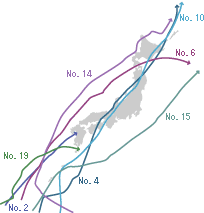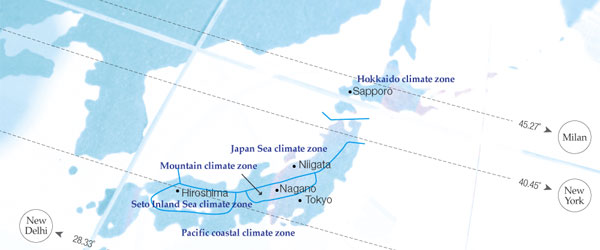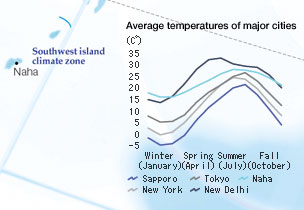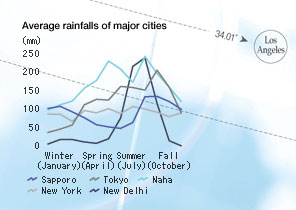 |
 |
Japan is an archipelago with an arc-like shape and a landmass of approximately
380,000 km2. Its islands extend off the eastern coast of the Eurasian continent.
With 4 main islands and about 7,000 small islands, Japan runs for about 3,000
km north to south. It has a mild oceanic climate and clearly demarcated seasons,
with a comparatively heavy rainfall. Climate in Japan does, however, vary significantly,
between north and south and between inland and coastal regions. Unlike most other
countries, Japan features three climate zones cool, warm and subtropical within
its territory, and has areas subject to heavy rain and areas that receive heavy
snow. East Asia is frequently subject to typhoons, an average of 27 per year,
40% of which approach Japan. From time to time, these typhoons cause enormous
damage. Located at the meeting place of four plates, Japan is also one of the
most earthquake-prone countries in the world, with a highly active crust under
its surrounding oceans and many active faults lying beneath its own surface.
Japan is richly blessed with the beautiful natural environment provided by its
four seasons and a diversity of landscapes. But it can also be subject to the
harsher side of nature. Indeed, nature expresses itself in many different ways
in Japan. |
 |
Japanese people have been living in close harmony with nature
since early times. We harvest the bounties of nature, often without stopping to
think of the relationship that people have with the natural environment. Because
of its geographical and climatic conditions, Japan is prone to natural disasters.
Typhoons bringing with them heavy wind and rain hit Japan three times a year on
average, and preparedness in this regard has been the most importance issue in
Japanese housing.
Half a century ago, in a search for superior wind resistance, the founder of Daiwa
House Industry was inspired by the hollow structure of plant stems. This marked
the birth of the prefabricated housing industry and the first steps of our Company
in the prefabricated industry. In the fifty years since then, we have been consistently
focused on developing new technologies to protect human life from natural threats.
That focus has translated into a broad array of excellent construction methods,
from prefabricated housing to the traditional wooden frame house and the two-by-four
method. Our R&D initiatives still adhere to the original thinking left to
us by our founder: recognize and respect the potential of nature and protect the
lives of people by developing new technologies that enable strong structure and
outstanding performance. |
|
|
| Year |
Typhoon number |
Month |
Top wind speed (mph) |
Regions affected |
|
|
| 2003 |
14 |
Sept. |
165 |
Miyakojima Island(Okinawa) |
Torrential rain, Storm-force winds |
| |
10 |
Aug. |
154 |
Whole country |
Torrential rain, Storm-force winds |
|
| 2002 |
21 |
Oct. |
118 |
Tokyo area, Northern Japan |
Storm-force winds |
| |
6* |
July |
103 |
Boso peninsula |
Torrential rain, Storm-force winds |
|
| 2001 |
16 |
Sept. |
113 |
Okinawa |
Torrential rain |
| |
15 |
Sept. |
95 |
Tokyo area |
Torrential rain |
| |
11 |
Aug. |
85 |
Kii Peninsula |
Torrential rain |
|
| *Together with seasonal rain front |
|
 |
|
 |



